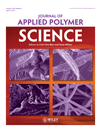Effect of the viscosity and processing parameters on the surface resistivity of polypropylene/multiwalled carbon nanotube and ethylene–propylene–diene/multiwalled carbon nanotube nanocomposites
Abstract
In this study, relatively large amounts of polypropylene (PP) and ethylene–propylene–diene (EPDM) were melt-mixed with multiwalled carbon nanotubes (MWCNTs). Although the melt-compounding method has many advantages, the uniform dispersion of carbon nanotubes in the polymer matrix is still the most challenging task. Because the electrical conductivity of composites is strongly influenced by the filler's state of dispersion and the extent of filler breakage during processing, the effects of the viscosity and processing conditions, such as the mixing time, rotor speed, and cooling rate, on the surface resistivity were studied. The PP/MWCNT nanocomposites displayed a high dependence of surface resistivity on the cooling rate, and the EPDM/MWCNT nanocomposites displayed a higher surface resistivity at the same content of MWCNTs and less dependence of surface resistivity on the cooling rate compared with PP/MWCNT nanocomposites. The increased surface resistivity of the EPDM/MWCNT nanocomposites was observed when EPDM with higher viscosity was used to prepare the EPDM/MWCNT nanocomposites. By increasing the rotor speed, lower surface resistivity was obtained in the PP/MWCNT nanocomposites. However, by increasing the rotor speed, a higher surface resistivity was obtained in the EPDM/MWCNT nanocomposites. © 2010 Wiley Periodicals, Inc. J Appl Polym Sci, 2011




